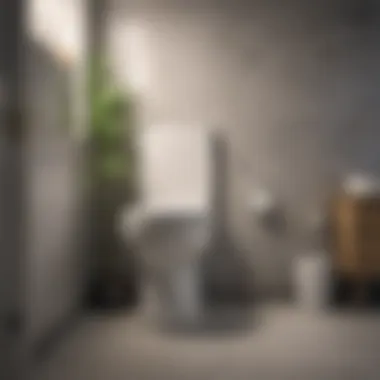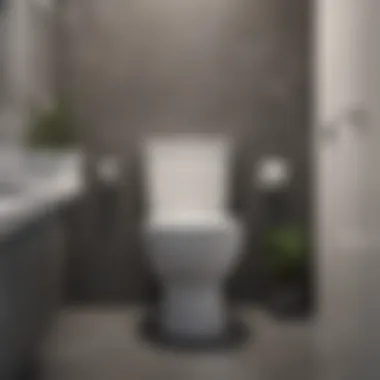Comprehensive Guide to Unclogging a Toilet Effectively


Intro
Unclogging a toilet is a common household issue that many confront at some point. It could be the result of excessive toilet paper, foreign objects, or even a poorly functioning plumbing system. Understanding how to address these situations effectively is vital for every homeowner and can save time, stress, and even money on professional services.
This guide will explore various methods and tools available for unclogging toilets, ranging from simple home remedies to advanced plumbing techniques. Not only are there multiple approaches for different types of blockages, but also, preventative strategies will be discussed to help maintain toilet functionality and avoid further clogs.
The ability to address plumbing issues efficiently can greatly enhance overall household comfort and convenience.
In this comprehensive exploration, we will cover everything from identifying the cause of a clog to providing effective solutions that allow for quick resolutions. Whether you are a seasoned DIY enthusiast or a novice in home maintenance, this guide aims to equip you with practical knowledge for toilet care. By diving into effective unclogging methods and maintenance strategies, you can ensure that your bathroom remains a functional and efficient space.
Understanding Toilet Clogs
Understanding toilet clogs is crucial for any homeowner, as it addresses a common yet disruptive issue. Toilets tend to get clogged due to various factors, and recognizing these factors can save time and prevent damage to plumbing systems. When toilets are clogged, they cannot serve their primary function, leading to inconvenience and potential sanitation issues. Delving into the causes and signs of clogs allows individuals to take appropriate action before troubles escalate.
By understanding how clogs form, homeowners can apply preventative measures, reducing the frequency of incidents. This knowledge empowers users to tackle minor issues independently rather than relying on professional plumbers for every problem.
Common Causes of Toilet Clogs
Several factors contribute to toilet clogs. These include but are not limited to:
- Excessive Toilet Paper: Using too much toilet paper in one flush is a leading cause of clogs. All toilet papers are not equal; thicker or more absorbent types can exacerbate this issue.
- Foreign Objects: Items like toys, sanitary products, or wipes often unintentionally find their way into toilets. These materials do not break down easily, leading to blockages.
- Flushing Non-Flushable Items: Products labeled as "flushable" do not always break down in water. Materials such as cotton balls, dental floss, or even some wipes can cause significant problems.
- Tree Roots: In some cases, tree roots can invade sewer lines, causing serious blockages that affect multiple fixtures in a home.
- Old or Damaged Pipes: Aging plumbing can lead to sediment buildup or cracks that contribute to clogs.
Identifying which cause is at play can inform how to best address the clog, providing a pathway to effective solutions.
Signs of a Clogged Toilet
Recognizing the signs of a clogged toilet early prevents further issues. Key signs include:
- Poor Drainage: Water remains in the bowl or rises higher than normal after flushing, indicating blockage.
- Gurgling Sounds: Unusual noises when the toilet flushes or when using sink drains nearby could suggest that air cannot escape the plumbing, often due to a clog.
- Slow Flushing: A toilet that takes longer than usual to flush indicates the beginning of a potential clog.
- Water Backup: Water may back up into other fixtures, such as sinks or bathtubs, signaling a more systemic issue.
When confronted with these signs, timely action is essential. Identifying and addressing clogs early on can save homeowners from costly plumbing repairs.
Assessing the Situation
Assessing the situation is a crucial first step when confronted with a clogged toilet. Understanding the nature and extent of the clog provides the foundation for choosing the appropriate method for resolution. This process can prevent unnecessary frustration and save time by directing the homeowner to the most effective solution.
Key Elements of Assessment:
- Recognizing the specific type of clog you are facing
- Evaluating whether the blockage is isolated to one toilet or affecting multiple fixtures
- Determining if there are any underlying plumbing issues that may have contributed to the problem
This initial evaluation allows for a focused approach. If the clog appears minor but persists, it may signal a more significant issue further down the line. Ignoring signs of a severe clog or plumbing issue could lead to larger problems and potentially more costly repairs.
Evaluating the Severity of the Clog
When evaluating the severity of a clog, it is essential to pay attention to the symptoms at hand. For instance, is the toilet slowly draining, or is it unable to drain at all?
- Slow Draining:
- Complete Blockage:
- Often indicative of a partial clog, which may be relieved through basic home remedies or a plunger.
- Can warrant a more thorough approach if water levels do not normalize after treatment.
- Suggests a more severe issue that requires immediate attention.
- May necessitate the use of an auger or professional help to avoid overflow or damage.
Understanding the characteristics of the blockage also aids in choosing appropriate tools. For less severe blockages, a plunger may suffice, while more stubborn clogs could indicate that an auger or a professional plumber is necessary.


Checking for Other Plumbing Issues
After assessing the initial clog, checking for other plumbing issues is vital. A clogged toilet might be a symptom of deeper systemic problems. Below are steps to take:
- Inspect for Gurgling Sounds:
Gurgling noises from wastewater draining can indicate air being trapped in the plumbing, suggesting a venting or drain line issue. - Look for Backflow in Other Fixtures:
If sinks or bathtubs also experience slow drainage, this could indicate a block in the main line. In such cases, further investigation is needed. - Frequency of Clogs:
Regular clogs can point to buildup in your plumbing system over time. Understanding the pattern can help identify if a more profound cleaning or plumbing upgrade is necessary.
To summarize, assessing the situation with a clear mind not only allows you to tackle the immediate issue but also prepares you for any underlying problems that might need addressing.
Basic Tools for Unclogging
When dealing with a clogged toilet, the right tools are essential for resolving the issue efficiently. Using the appropriate equipment can make the difference between a quick fix and a lengthy, frustrating ordeal. In this section, we will explore the basic tools necessary for unclogging toilets, their functions, and how to use them effectively.
Plunger Types and Uses
Plungers are the most common tool for unclogging toilets. They work by creating pressure and suction to dislodge blockages. There are two main types of plungers: the cup plunger and the flange plunger.
- Cup Plunger: This is the standard plunger that most people know. It has a rounded rubber cup at the end. It's effective for sinks and tubs but not always the best choice for toilets due to its design.
- Flange Plunger: Specifically designed for toilets, this plunger features an extended rubber flange that fits into the toilet drain. It seals better against the toilet’s rim, maximizing the suction needed to unclog the toilet. For best results, keep one of these on hand.
Using a flange plunger correctly involves placing it in the toilet bowl and ensuring the flange is positioned inside the drain. Push down gently before applying harder strokes to create suction. Repeat this motion until the clog is cleared, often indicated by a noticeable change in water flow.
Augers and Drain Snakes
When plunging fails to resolve the issue, an auger or drain snake can be a valuable tool. These devices are designed to reach deeper into the plumbing system to break up stubborn clogs that are not accessible by plunging alone.
- Toilet Auger: This tool consists of a flexible cable with a coiled tip. Insert the auger into the toilet bowl and turn the handle to extend the cable into the drain. It can break apart or retrieve objects causing the blockage.
- Drain Snake: Similar to a toilet auger, a drain snake can be used in various plumbing fixtures. While it may be less effective in a toilet, it can be used in other drains in your home, making it a versatile tool.
Using an auger requires a gentle and steady approach. Insert the cable slowly and avoid forcing it, as this could damage your toilet. If you encounter resistance, gently twist and push to break through the clog.
Two essential tools in your unclogging arsenal, the plunger and auger each provides unique advantages for tackling toilet clogs. Acquiring both can help you deal with a range of issues effectively.
"Adequate preparation with the right tools can prevent a simple clog from becoming a serious plumbing issue."
Understanding the functions of these tools can significantly enhance your ability to maintain your toilet's functionality. Equip yourself with these basic tools and be ready to tackle any clog that may arise.
Home Remedies for Minor Clogs
Understanding home remedies for unclogging toilets is essential in maintaining an efficient plumbing system and minimizing emergency repairs. These methods are often simple, cost-effective, and can be performed without specialized tools. Home remedies not only provide an immediate solution for minor clogs, but they also reduce reliance on commercial products that may contain harsh chemicals, which can be detrimental to the environment and internal plumbing.
Adopting these methods allows homeowners to tackle minor issues promptly, preventing them from escalating into more serious plumbing problems. Additionally, using home remedies can save time and expenses associated with hiring a professional plumber for every minor blockage.
Hot Water and Dish Soap Technique
One of the most effective home remedies for minor toilet clogs involves using hot water and dish soap. This method works well for clogs caused by organic materials, such as toilet paper or waste. The dish soap acts as a lubricant, breaking down the solids, while the hot water helps in dissolving the blockage.
Steps:
- Gather materials: You will need a container to hold hot water and a few squirts of dish soap.
- Add dish soap: Pour about half a cup of dish soap into the toilet bowl.
- Heat water: Boil a kettle of water. Make sure the water is hot, but not boiling, to avoid damaging the porcelain.
- Pour water: Carefully pour the hot water from waist height into the toilet bowl.
- Wait: Allow it to sit for about 10-15 minutes.
- Flush: Observe if the water drains properly after waiting.
This method is simple and effective in many cases, especially if done soon after the clog occurs. However, if the clog persists, further intervention might be needed.
Baking Soda and Vinegar Method
Another popular and effective home remedy utilizes baking soda and vinegar. This combination creates a chemical reaction that can help to break down the clog, effectively clearing out minor blockages. The effervescence produced helps dislodge debris caught in the drain.
Steps:


- Preparation: Begin by ensuring the toilet bowl has minimal water, as excessive water may dilute the effect of the remedy.
- Add baking soda: Pour one cup of baking soda into the toilet bowl.
- Add vinegar: Follow this with two cups of vinegar. The mixture will begin to fizz and bubble upon contact.
- Let it work: Allow the mixture to sit for 30 minutes to an hour.
- Flush the toilet: After waiting, flush to see if the clog has cleared.
This method can be particularly helpful if you find yourself with a recurring clog. It is a preventive step that can keep your plumbing system healthier over time.
Using home remedies can be highly effective for minor clogs and save time and costs associated with professional help.
In summary, these home remedies not only work effectively for minor clogs but also highlight the importance of regular toilet maintenance. Implementing these strategies empowers homeowners to handle their plumbing issues in a sustainable and efficient manner.
Using a Plunger Effectively
Using a plunger is a fundamental skill every homeowner should master. It is essential for addressing toilet clogs, as it often serves as the first line of defense against blockages. A plunger can save you from costly plumbing services and lengthy waiting times. By understanding the right techniques and methods, you can enhance your ability to clear clogs efficiently.
This section will focus on two key aspects: proper plunging technique and the significance of timing and pressure in plunging. Both are crucial for successful unclogging.
Proper Plunging Technique
To effectively unclog a toilet, one must utilize the correct plunging technique. Here are several steps to ensure effective use of a plunger:
- Choose the Right Plunger: The best option for toilets is a flange plunger, which has a soft rubber cup and an extended lip. This design creates a better seal in the toilet bowl.
- Ensure Proper Sealing: Place the plunger into the bowl, ensuring that the cup covers the drain hole fully. The seal is essential for effective pressure application.
- Submerge the Plunger: The cup should be submerged in water before applying pressure. If the water level is too low, add more water or, if necessary, use a bucket.
- Plunge with Control: Begin the plunging motion slowly. Push down gently at first, without breaking the seal. Pull back to create negative pressure, then push down hard. Aim for effective thrusts, typically around 5 to 10 times.
- Monitor Changes: After several plunges, watch for changes in water levels. A drop indicates a successful unclogging.
Remember, patience is key. Insisting on quick results may disrupt the process.
Timing and Pressure in Plunging
The efficacy of plunging is not only determined by technique but also by timing and pressure. Understanding these elements can lead to a more effective unclogging experience.
- Timing: The intervals between plunging strokes matter. After each push and pull cycle, pause for a moment to observe any changes in the bowl. If the water begins to recede, continue plunging.
- Pressure Application: Use firm and consistent pressure. Too little pressure won’t create the necessary force to dislodge the clog. Conversely, excessive pressure can cause splashback or damage the toilet.
Advanced Techniques for Stubborn Clogs
Dealing with stubborn toilet clogs often requires more than the basic methods of unclogging. At this point, understanding advanced techniques is crucial for ensuring your plumbing works optimally. These methods can address deeper blockages or issues that simple approaches cannot effectively resolve. Proficiency in these techniques can save time and prevent frustration, making them an essential part of every homeowner's toolkit.
Using an Auger or Drain Snake
An auger, often referred to as a drain snake, is a key tool for tackling tough clogs. This device allows you to reach deeper into the plumbing system compared to a standard plunger. When using an auger, insert the snake into the toilet bowl and gradually feed it into the drain. As it reaches the blockage, you can twist and push to break it apart or retrieve it altogether.
- Preparation: Before using an auger, clear the surrounding area to prevent any mess. It might be wise to wear rubber gloves and protect your floor with towels or old newspapers.
- Inserting the Auger: Carefully guide the snake into the toilet. Twist the handle while pushing slightly to gain traction against the clog.
- Break Up the Clog: Allow the auger's tip to reach the blockage. Once you feel resistance, turn the handle to break the obstruction. This method works well for solid waste or foreign objects lodged in the pipes.
- Extraction: If the auger snagged an object, pull it out slowly. Dispose of the material properly to avoid future issues.
The auger is beneficial because it is reusable and can reach deeper clogs than typical home remedies. Mastery of this tool can save maintenance costs in the long run.
Chemical Drain Cleaners: Pros and Cons
Chemical drain cleaners can offer an immediate solution for stubborn clogs. These products contain active ingredients that dissolve blockage materials like hair, grease, or soap scum. However, using these chemicals demands cautious consideration.
Pros:
- Speed: Chemical cleaners often work faster than mechanical methods, providing quick relief.
- Ease of Use: Simply pour the cleaner, wait for a specified time, and flush with water.
- Accessibility: Available in stores, they are easy to purchase and use.
Cons:
- Pipe Damage: Frequent use may harm plumbing pipes, particularly older or fragile systems.
- Harmful Chemicals: Many chemical cleaners are toxic and can be hazardous to both health and the environment.
- Ineffectiveness on Certain Clogs: These cleaners may not work on more structured blockages caused by physical objects or heavy buildup.
In summary, chemically-laden solutions can be effective in a pinch, but they come with severe drawbacks. Consider employing mechanical methods as a first line of defense, reserving chemical options for particularly challenging scenarios. Ultimately, understanding when to use which method can help maintain your plumbing health over time.


"Utilizing the proper unclogging method ensures not only a functional toilet, but also prolongs the lifetime of your plumbing infrastructure."
Preventative Measures for Clogs
Preventative measures for toilet clogs are essential for homeowners. By taking proactive steps, one can minimize the likelihood of facing an unpleasant blockage. Understanding the importance of regular upkeep can extend the life of your plumbing and provide a hassle-free experience when using your toilet. Maintaining a clean and functional toilet environment not only enhances the comfort of the users but also saves on potential plumbing costs in the long run.
Regular Maintenance Practices
Regular maintenance practices are a cornerstone of effective toilet management. Simple tasks can prevent serious issues before they arise. Here are some key actions homeowners should consider:
- Routine Cleaning: Regularly clean your toilet using non-abrasive cleaners. This helps eliminate buildup that might lead to clogs.
- Check for Flushing Issues: Make a habit of checking if the toilet flushes completely. Partial flushes can indicate an underlying problem, such as a blockage in the trap.
- Monitor Toilet Usage: Educate household members on what can and cannot be flushed. Items like feminine hygiene products, paper towels, or excess toilet paper can easily lead to clogs.
By implementing these practices regularly, you create a smooth plumbing flow, ultimately decreasing the chances of experiencing a clog.
Educating Household Members
Educating household members about toilet use is equally important in preventing clogs. Everyone using the toilet should know how to maintain its function. Consider these points:
- Communicate the Do's and Don'ts: Share knowledge about proper flushing habits and the materials that can clog toilets. Clear information helps in setting expectations.
- Establish a Routine Check: Encourage family members to look for signs of potential issues after using the toilet, such as unusual sounds or slow drains.
- Involve Children: Teach children the right way to use the toilet, including the importance of flushing once. Early education can prevent bad habits that lead to clogs.
When to Call a Professional Plumber
Determining when to contact a professional plumber can save significant time, effort, and money in the long run. Many toilet clogs can be addressed using basic tools and methods. However, stubborn blockages or more complex plumbing issues require expertise to avoid potential damage. Understanding when to call for help is as essential as knowing how to clear a clog.
Identifying Serious Issues
Some signs suggest that the clog is not typical. These may include:
- Frequent Clogging: If your toilet keeps clogging even after using various unclogging methods, this could indicate a deeper issue, such as a blocked sewer line or a malfunctioning septic system.
- Multiple Fixtures Affected: If you notice that not just one, but several fixtures are having drainage issues, this points toward a systemic problem in the plumbing.
- Gurgling Sounds: Unusual sounds from plumbing fixtures when trying to flush can indicate trapped air or an obstruction in the drain line.
Identifying these issues early can prevent further complications. Homeowners should be diligent. Keep track of your toilet's performance to spot signs of trouble sooner rather than later.
Understanding Plumbing Costs
Understanding costs associated with hiring a professional plumber helps in making informed decisions. Plumbing services can vary widely based on:
- Type of Service: Simple services like unclogging may be lower in cost than those involving major repairs or replacements.
- Location: Rates may fluctuate based on your geographical location and the local market's average pricing.
- Emergency Calls: If you need immediate assistance after hours, you may face higher rates for emergency plumbing services.
It's wise to always ask for a written estimate before any work begins. You can then budget your finances and avoid unexpected expenses. Knowing the typical costs can streamline this process. For further assistance, the American Society of Home Inspectors offers some great resources.
The End
In the context of toilet maintenance, the conclusion serves as a vital component of this comprehensive guide. It synthesizes the information presented throughout the article and reinforces the significance of effective unclogging methods. Readers should realize that managing toilet clogs is not merely an inconvenience but can reflect broader plumbing issues in their homes.
Recognizing the importance of regular maintenance can prevent severe blockages, ensuring the functionality of toilets over time. Homeowners gain substantial benefits from understanding both basic and advanced techniques for dealing with clogs. This knowledge not only empowers individuals to tackle minor issues quickly but also highlights when a professional intervention is necessary.
Good toilet maintenance involves continuous learning and awareness. By engaging with the methods shared, like preventive actions, homeowners can foster a healthy plumbing environment. The key takeaway here is simple: a well-maintained toilet system enhances comfort and efficiency in daily life. Routine checks and practices can save both time and money in the long run.
Summary of Key Points
- Understanding common causes of clogs leads to quicker resolutions.
- Regular maintenance helps reduce the likelihood of future blockages.
- Home remedies like using baking soda or hot water can be quite effective for minor clogs.
- Knowing when to use specialized tools, such as augers, allows for tackling stubborn issues.
- Awareness of plumbing costs prepares homeowners for potential repairs.
The importance of these key points cannot be overstated. They guide homeowners in developing effective habits, thereby mitigating plumbing issues efficiently.
Final Thoughts on Toilet Maintenance
Toilet maintenance often ends up being overlooked until a clog presents itself. However, by adopting a proactive approach, homeowners can drastically reduce the occurrence of clogs. This includes educating household members about what items should or shouldn’t be flushed down the toilet.
Consider implementing the following practices:
- Routine inspections: Check for slow flushing and other issues regularly.
- Educate others: Make sure everyone knows the limits of toilet use to avoid unnecessary clogs.
- Utilize home remedies promptly when minor issues arise.















